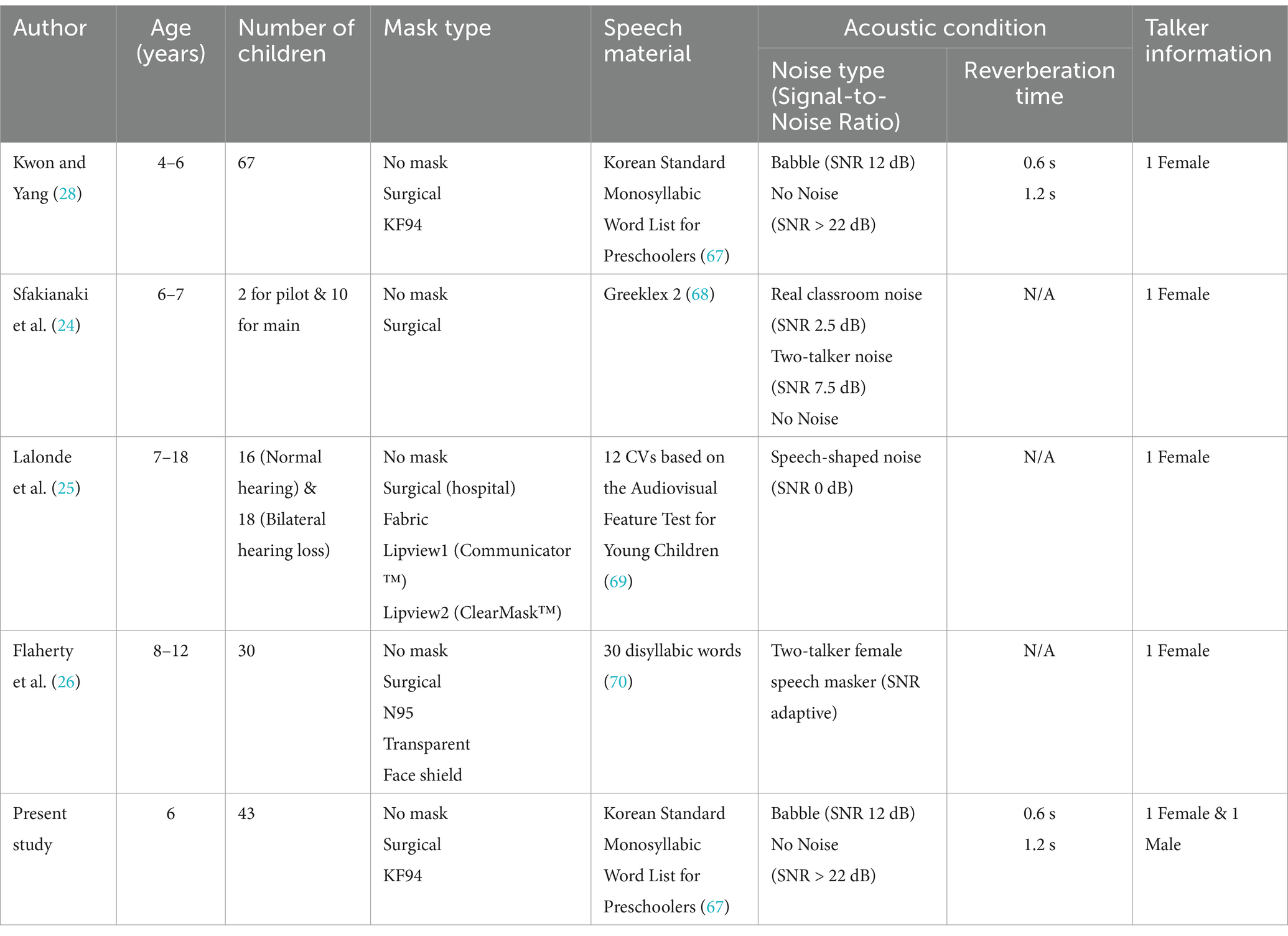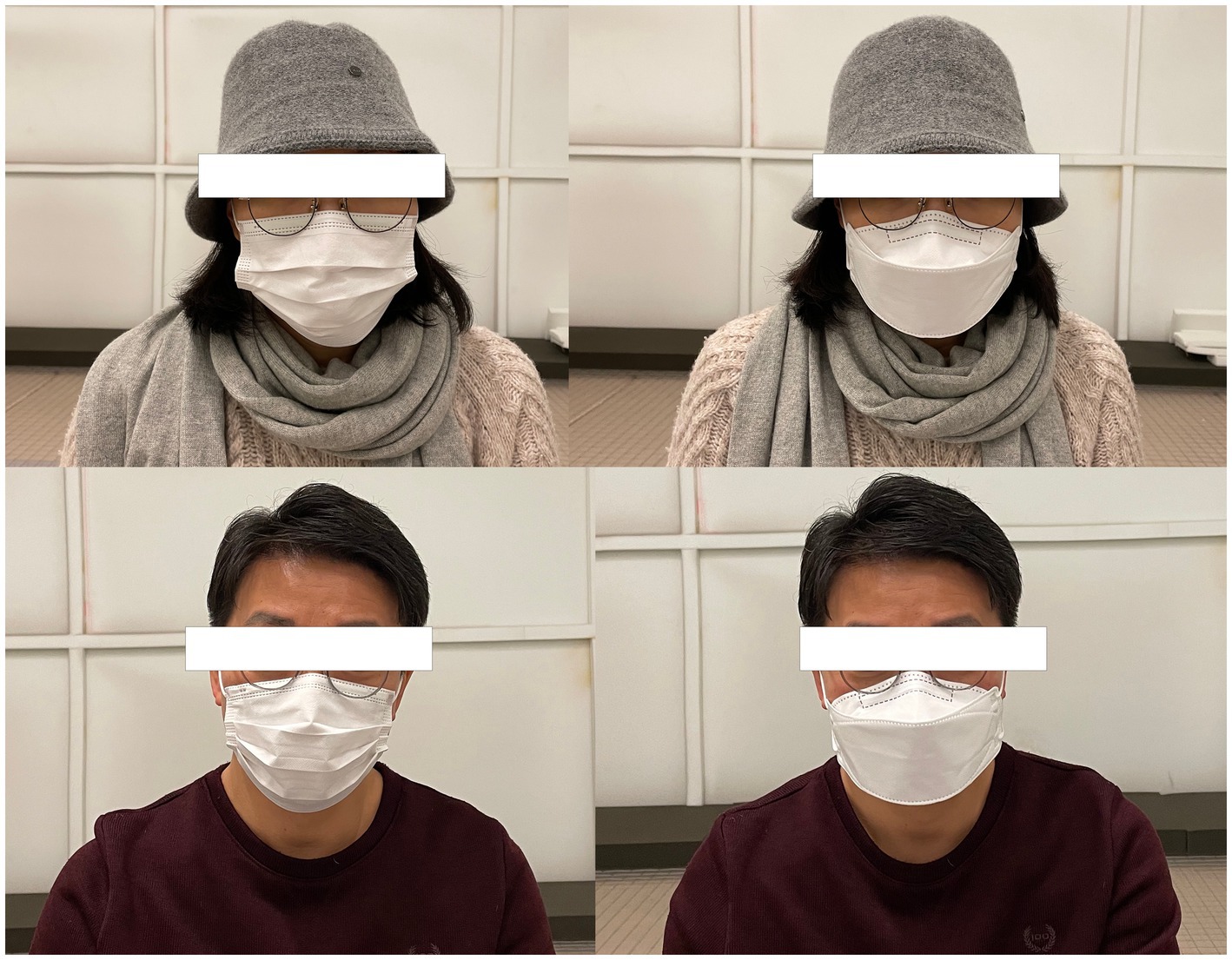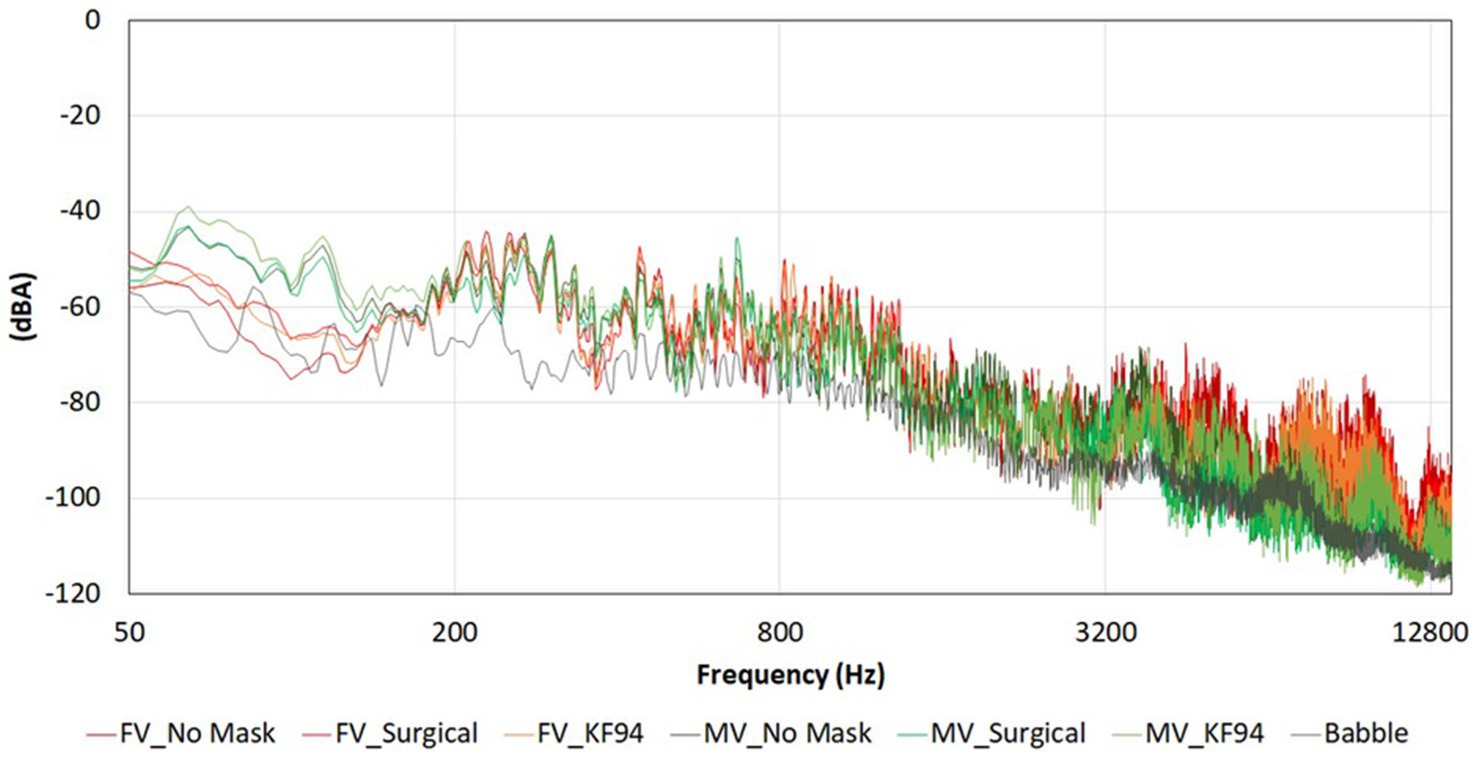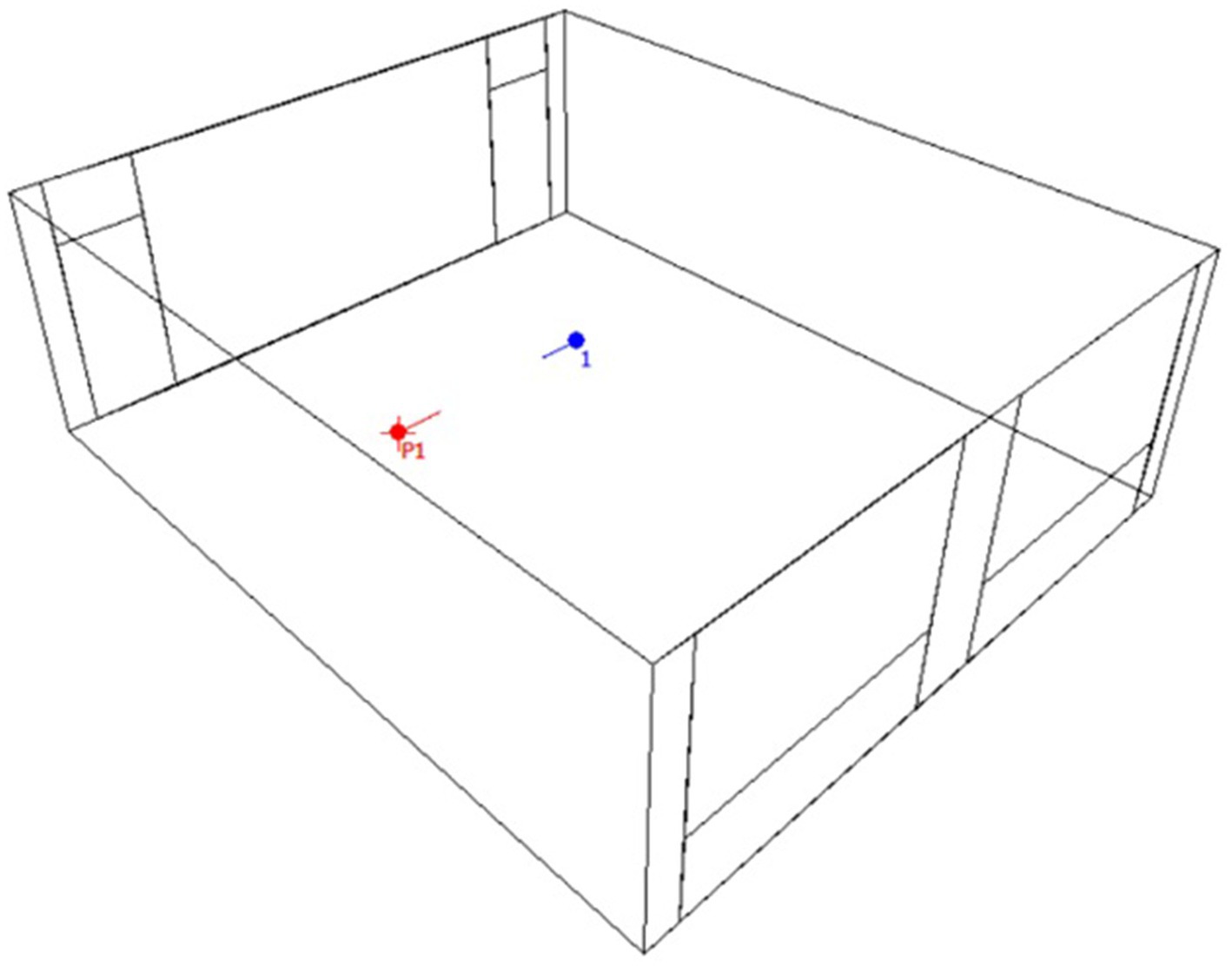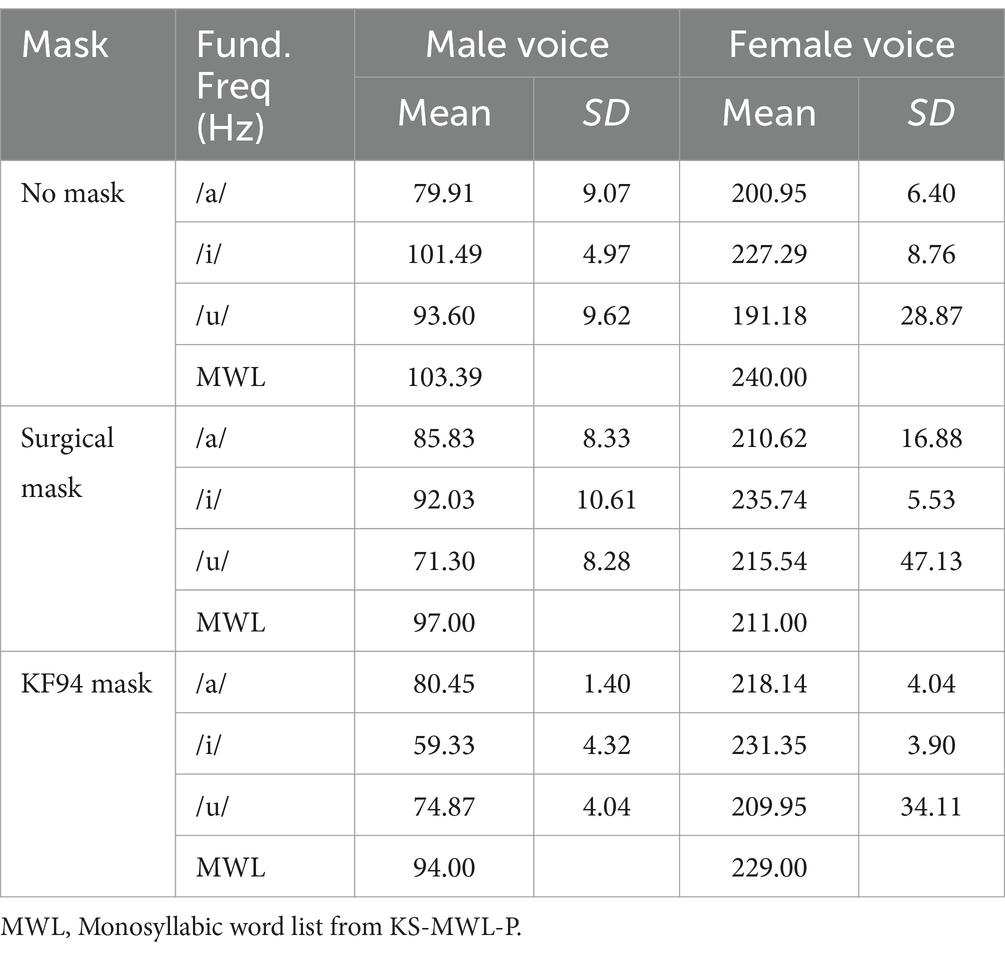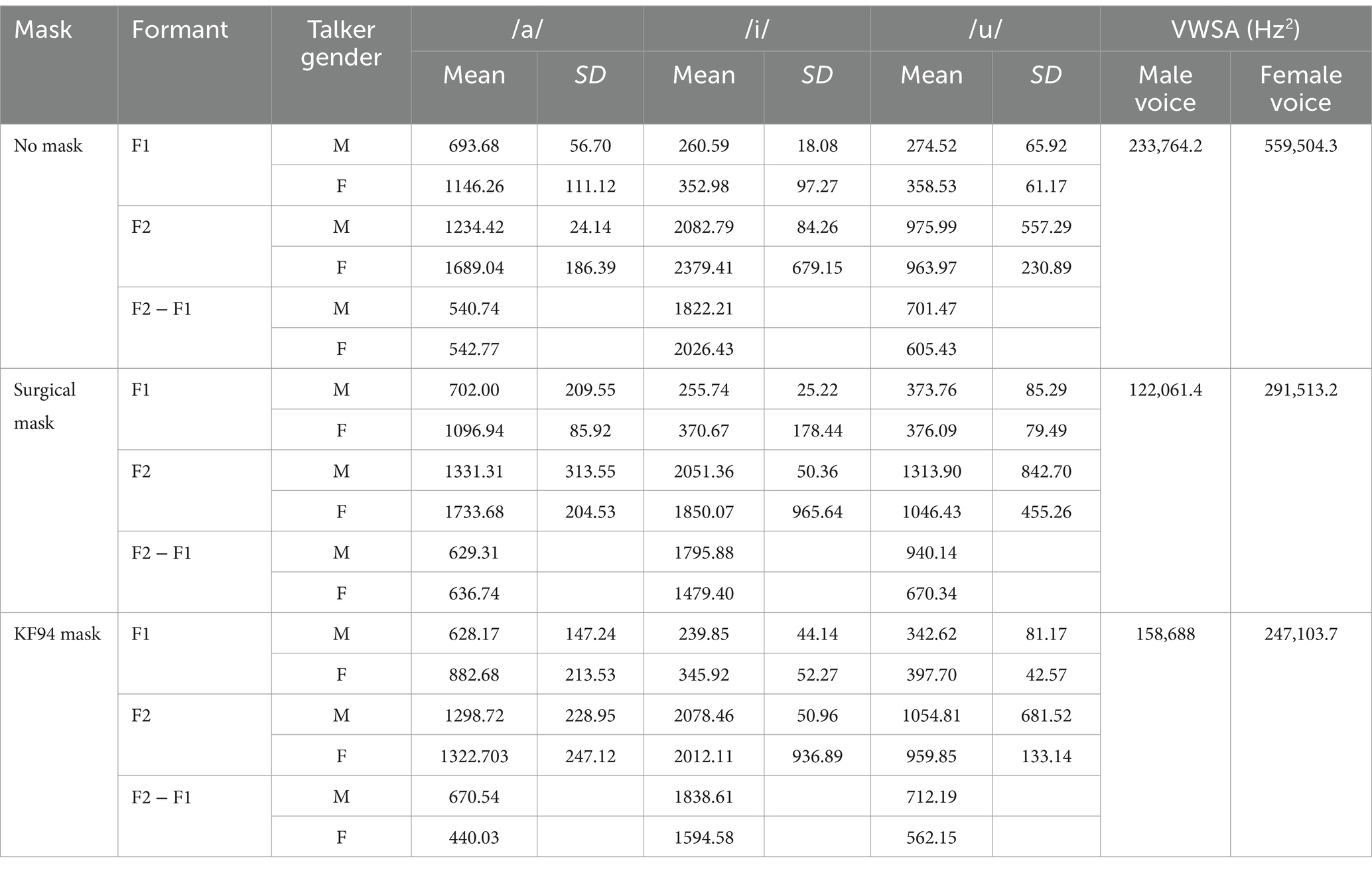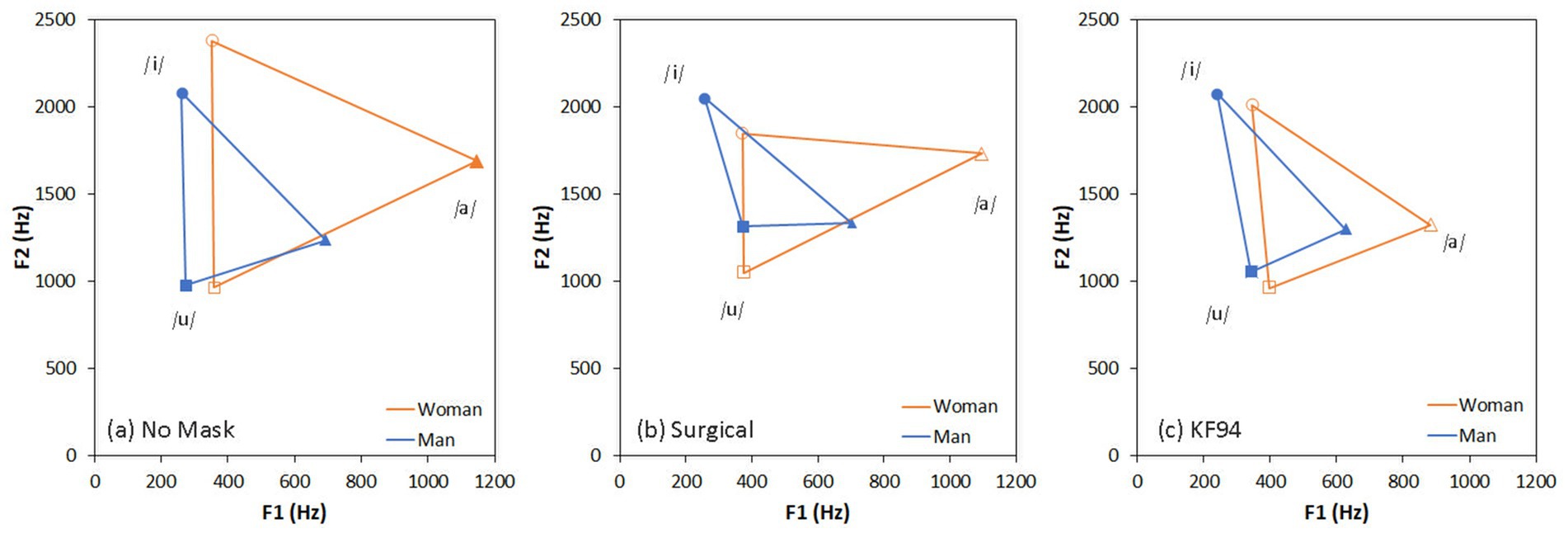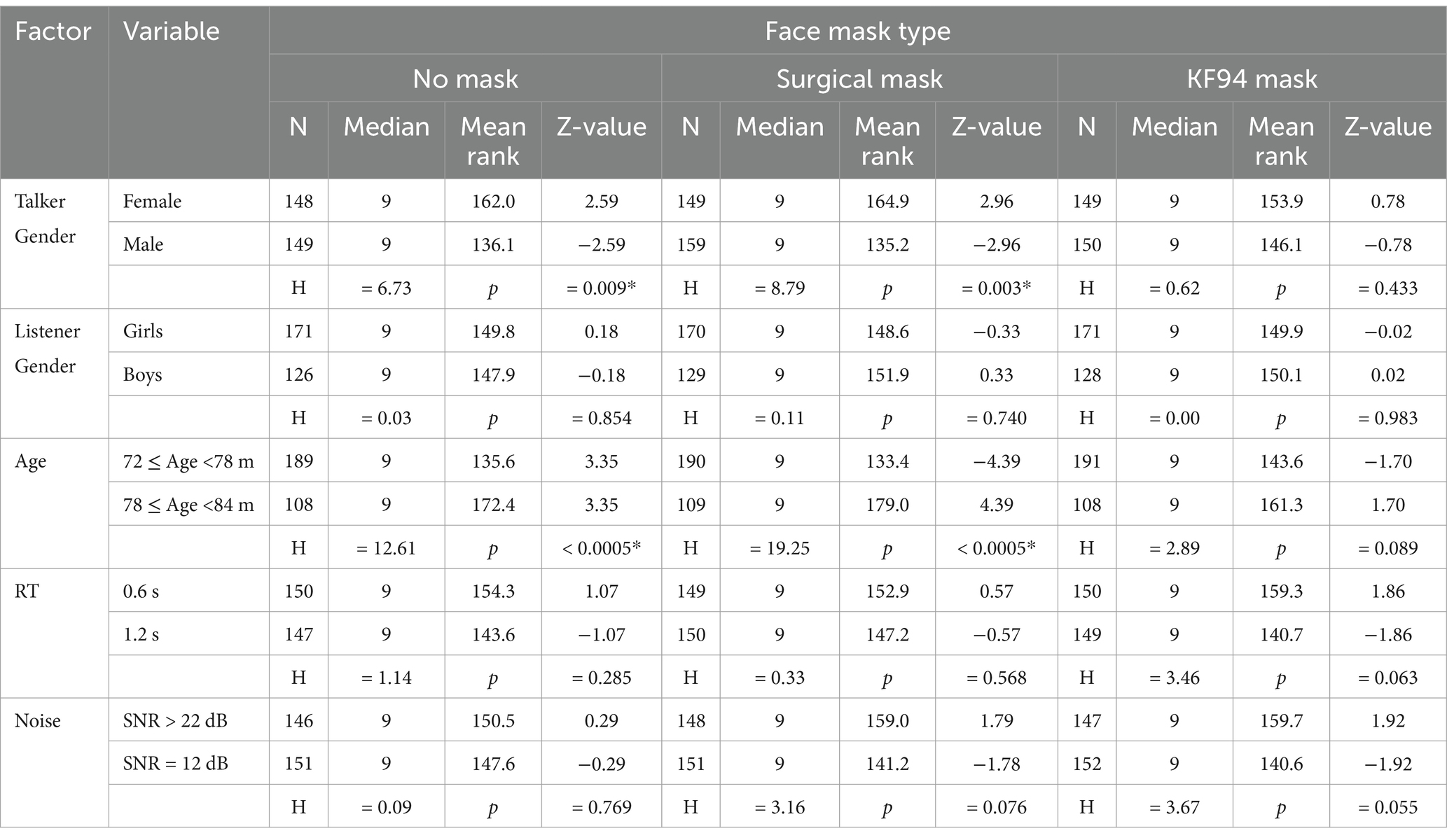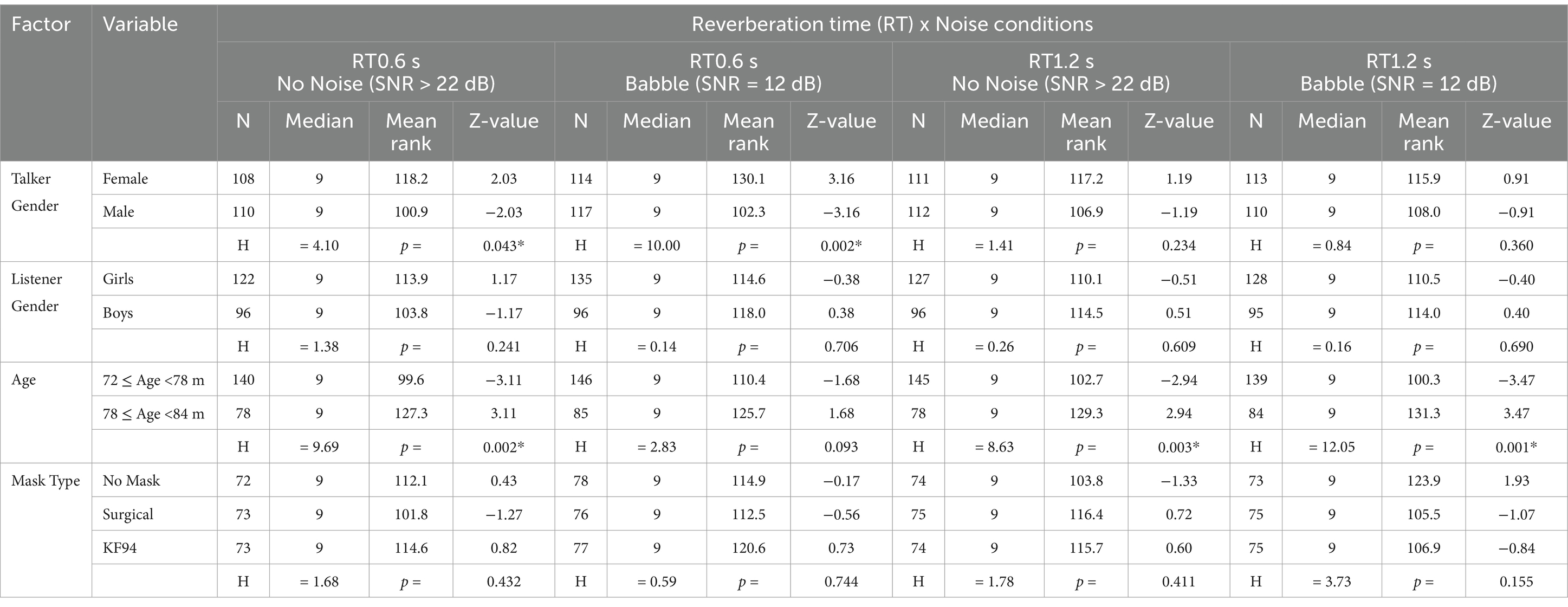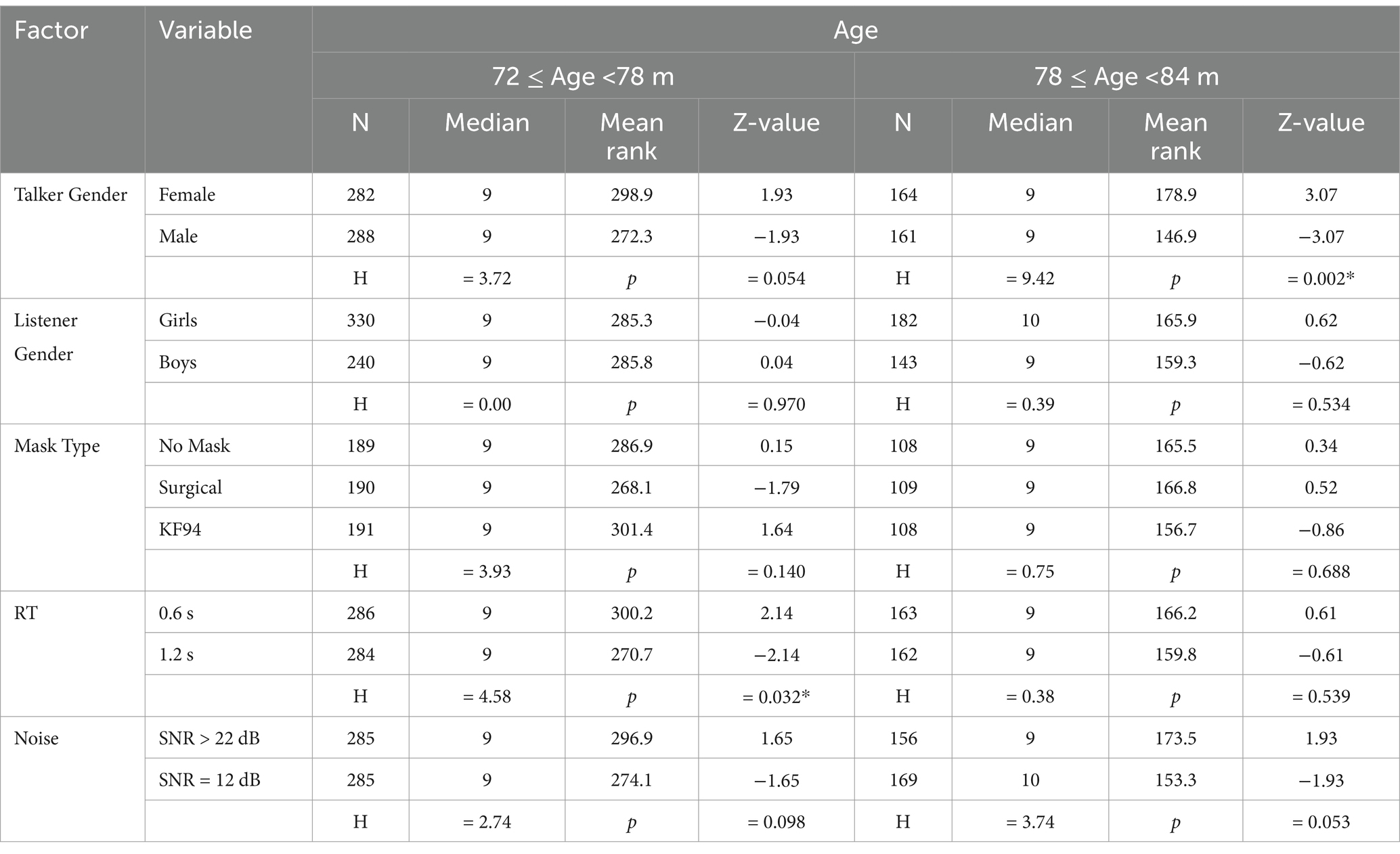- 1Department of Speech-Language Pathology, College of Health Welfare, Gwangju University, Gwangju, Republic of Korea
- 2Division of Architecture, College of Engineering, Gwangju University, Gwangju, Republic of Korea
Although mandatory wearing of face masks for 3 years owing to COVID-19 might have strongly affected children’s language development, its effects on their speech recognition based on the talker’s gender remain unknown. This study examined how face mask usage affects children’s speech recognition, focusing on the interaction between the talker’s gender and the child listener’s characteristics under realistic acoustic conditions with room reverberation and background noise. Speech recognition was assessed in 43 6-year-old children who had worn masks for two or more years during preschool. Auralisation techniques using male and female professional voice actors’ recordings under varying room reverberation and background noise conditions were used for the assessment. The assessment revealed significant talker gender effects, both with and without face masks. Gender interactions were observed, with girls demonstrating significant differences in speech recognition scores based on talker gender, whereas boys showed no such variations. Face masks attenuated the talker gender effect on speech recognition. Listener gender showed no significant impact in the overall analysis; however, thicker face masks were associated with improved speech recognition at lower reverberation times and noise levels. Reverberation time significantly affected speech recognition only in younger children (mean age: 74 months). Face masks reduced vowel working space areas across both genders. Thus, optimising the acoustic environment is crucial for younger children wearing face masks in educational settings. This study has important implications for classroom acoustics and educational spaces during periods of mandatory mask usage.
1 Introduction
Wearing face masks in educational settings has been widely adopted in Korea since the World Health Organisation (WHO) declared an international public health emergency on 30 January 2020 (1). Although wearing a mask outdoors has been voluntary rather than mandatory since 2 May 2022 (2), wearing a mask indoors in schools was made voluntary on 30 January 2023 (3). Additionally, on 11 May 2023, the government’s COVID-19 response headquarters decided to downgrade COVID-19’s status as an emergency (4). According to the revised regulations, the mandatory indoor mask requirement, which previously applied to school buses and tour vehicles, was abolished in June 2023.
The mandatory mask-wearing policy in Korea, which was implemented without a strong lockdown policy (5), has been considered a successful control measure for COVID-19 over the last 3 years. However, it may have affected children undergoing the critical period of language and speech development (6), who have been wearing face masks for over 3 years. Although language development progresses most rapidly until approximately 3.5 years of age (7), continued development during the preschool years remains crucial for phonological mastery (8). Our study examined six year olds who had worn masks for more than two consecutive years (ages 4–6) during this important developmental window. The language capabilities of children at this age serve as a foundation for their academic language skills (9, 10). Therefore, understanding how face masks affect speech recognition in 6 year olds, especially given their extended mask use during preschool, is vital for assessing potential impacts on their linguistic development.
Previous studies have shown that mask-wearing among adults introduces certain challenges in verbal communication and creates a complex acoustic environment that affects sound transmission, language intelligibility, and perceptual comprehension across diverse audiences and environments. Although face masks change the talker’s speech signal, some specific acoustic features, such as voice quality (11), cepstral peak prominence, and vocal intensity (12), are largely unaffected, irrespective of mask type. Face masks are linked to changes in spectral density characteristics that resemble a low-pass filtering effect, thereby reducing the intensity of sounds at higher frequencies, with varying effect sizes (12–14). N95 (US standard) (15) or KN95 (China standard) (16) masks showed a more pronounced impact on speech acoustics than surgical masks (13, 17). The energy ratio between 0 and 1 kHz and 1–8 kHz (LH1000) for sentences significantly increased while wearing either a surgical or KN95 mask (12). The harmonics-to-noise ratios for vowels (18), phrases, and sentences were higher in the mask-wearing conditions than in the no-mask condition (12). KF94 masks (Korea standard comparable to N95 in filtration) (19) demonstrated comparable Speech Transmission Index (STI) attenuation to surgical masks; however, surgical masks exhibited speech level reduction at frequencies of 4 kHz and above, whereas KF94 masks produced attenuation effects at lower frequencies, beginning at 2 kHz (14). The combination of face masks and background noise negatively impacts speech intelligibility for adult listeners (20–22). Badh and Knowles (23), in their scoping review, reported that face masks consistently impact acoustic features of speech, including vocal intensity, measures related to voice quality, and acoustic-phonetic aspects of speech production. Speech intelligibility studies using everyday background noise have documented substantial degradation when speakers wear face masks (24–27).
The impact of face masks on children’s speech recognition is a relevant area of research, with multiple studies examining how different mask types and environmental conditions affect young listeners’ ability to understand spoken language (Table 1). Kwon and Yang (28) found that masks and reverberation times (RT) impaired speech recognition more severely in 4- to 5 year olds than in 6 year olds (n = 67) in both quiet and noisy conditions. Children’s speech recognition was significantly impaired by KF94 masks but not by surgical masks. Sfakianaki et al. (24) found that children aged six and seven (n = 12) exhibited diminished word recognition in noisy conditions with a surgical mask, despite this mask type having minimal structural interference with speech transmission owing to its loose-fitting design. Lalonde et al. (25) found that the combination of noise and face mask conditions negatively impacted speech understanding in older children aged between 7.4 and 19.8 years with (n = 18) and without (n = 16) hearing loss. Under auditory-only conditions without visual cues, surgical masks demonstrated optimal performance, with comprehension levels statistically equivalent to unmasked speech. Flaherty et al. (26) also explored the effects of different face masks on word recognition in children aged 8–12 years (n = 30) using a two-talker speech masker. They found that the effects depend on the type of face mask being worn. The face shield and transparent mask degraded children’s speech recognition. However, children’s speech recognition in the no-mask condition did not differ from that in either the surgical or N95 masks conditions. All four previous studies (24–26, 28) found that face masks degraded speech recognition in children. However, the effects of each mask type differed (24–26, 28), likely owing to factors such as experimental methods and the age of the target children in limited experimental configurations. Age-related variations in mask effects on speech recognition emerged distinctly across studies. Early childhood research (24, 28) demonstrated developmental differences, with 6 year olds showing better mask tolerance compared to 4- to 5 year olds (n = 67) (28), though 6- to 7 year olds (n = 12) still exhibited compromised word recognition with surgical masks in noisy conditions (24). Studies of older children (25, 26) revealed different patterns: investigations spanning 7.4–19.8 year old including hard-of-hearing participants (25) and a focused examination of children aged 8–12 years (n = 30) (26) demonstrated less mask interference, particularly with surgical masks, suggesting age-dependent improvements in masked speech recognition performance. Studies examining 6-year-old children revealed contrasting findings: Kwon and Yang (28) found that their word recognition scores did not differ significantly between masked and unmasked conditions when they used surgical masks. By contrast, Sfakianaki et al. (24) reported decreased word recognition performance with surgical masks in noisy conditions, although their smaller sample size (n = 12) may limit generalisability compared to Kwon and Yang’s (28) larger cohort (n = 67). Research focused specifically on 6 year olds is needed to resolve the contradictory findings, particularly given the methodological differences and sample size variations in these studies.
While studies have examined how masks affect speech recognition in children of different ages, another important variable is the gender of the speaker, as it can significantly influence speech intelligibility both with and without masks. Despite its importance, talker gender effects on speech are understudied, with many studies overlooking their possible influences (29). Moreover, studies examining gender differences in speech intelligibility have shown inconsistent findings. Research has demonstrated gender differences in speech intelligibility without masks, gender-specific adaptations to speaking in noisy conditions, and distinct acoustic modification strategies between male and female speakers. Female talkers demonstrated higher intelligibility than other groups of talkers (27, 30–33). In a study of 20 talkers and 200 listeners, Bradlow et al. (30) constructed the profile of a highly intelligible talker as female, producing sentences with a relatively wide range in fundamental frequency (F0), employing a relatively expanded vowel space that covers a broad range in F1, precisely articulating her point vowels, and demonstrating high precision in inter-segmental timing. Markham and Hazan (31) tested intelligibility using a real-word open-set perception test with four talker groups (18 women, 15 men, 6 girls, and 6 boys) and three listener groups (45 adults, 45 children aged 11–12, and 45 children aged 7–8). They also noted that female talkers exhibited higher intelligibility, which led them to conclude that talker intelligibility is primarily influenced by factors inherent to the talker rather than by a combination of factors involving both the talker and listener. Ferguson (32) tested vowel intelligibility in clear and conversational speech with four talker groups (11, 18–24 years; 10, 25–31 years; 10, 32–38 years; and 10, 39–45 years) and found that female talkers performed better in clear speech vowel intelligibility compared to male talkers. In a study of 20 male and 20 female talkers, Kwon (33) found that women exhibited significantly higher speech intelligibility scores than men, with significant differences between men and women in most acoustic parameters: F0, F0 range, formant frequency, formant ranges, vowel working space area, and vowel dispersion. Kwon and Yang (27) investigated the effects of face masks and gender on speech recognition for university students and found that the male speaker exhibited significantly degraded speech recognition with a signal-to-noise ratio of 0 dB. These documented acoustic and phonetic differences suggest that masks could differentially affect speech transmission and recognition based on talker gender.
Although these studies have demonstrated female talkers’ superior intelligibility in certain contexts, other studies have presented contrasting findings, particularly in conversational settings (34–36). Gengel and Kupperman (34) tested word discrimination in noise with 42 college students using three female and three male talkers. They found that the rank order of speaker intelligibility scores was not related to the speaker’s gender and therefore did not account for the differences found. Bradlow and Bent (35) used the Revised Bamford-Kowal-Bench Standard Sentence Test with two talkers and 64 adult listeners and found no talker gender effect for conversational speech or clear speech. Bradlow et al. (36) investigated speech-in-noise perception abilities in children with (n = 63) and without (n = 36) learning disabilities, using both male and female talkers. They also reported that listeners perceived both talkers to have equivalent baseline conversational speech intelligibility. By contrast, the clear speech intelligibility of the female talker was significantly higher than that of the male talker, leading to an overall greater clear speech benefit observed for the female talker than the male talker. Ferguson and Morgan (37) investigated talker differences in clear and conversational speech in young adults with normal hearing and in hard-of-hearing older adults. They also showed that women received significantly higher ratings than men for clear speech but not for conversational speech. Moreover, the gender difference was noticeably greater for young normal-hearing listeners than for hard-of-hearing older listeners.
The present study investigated how face masks affect speech recognition in 6-year-old Korean children—an age that marks a critical transition in language development and early academic learning. We examined differences between male and female talkers using auralised classroom acoustics to reflect real-world conditions. This study addresses a gap in understanding how talker gender influences masked speech perception during this crucial developmental stage, which is particularly relevant given the prolonged mask use.
2 Methods
2.1 Listeners
Forty-three 6-year-old children (19 boys and 24 girls) participated in the study with parental consent. The informed consent procedure was approved by the Institutional Review Board of Gwangju University. All the children were monolingual Korean speakers. Study participants attended preschool during a period of mandatory mask requirements, with daily mask usage exceeding 8 h over more than 24 months in the Gwangju region at the time the study was conducted. We assessed children’s hearing status using questionnaires completed by parents or guardians. Potentially hard-of-hearing participants were excluded based on reports from their parents or guardians. Parents may underestimate their children’s hearing loss, particularly for mild or unilateral deficits and those primarily affecting non-speech frequencies (38, 39). However, parents can often detect speech-related hearing issues without formal testing (39). The Receptive and Expressive Vocabulary Test (REVT) (40, 41) for Koreans was used to evaluate children’s language development. By confirming age-appropriate vocabulary skills through REVT, we could attribute differences in word recognition performance to the experimental conditions (masks, reverberation time, talker gender) rather than to underlying language development variations. We excluded data from five children with developmental language delay from the analysis. The speech recognition test and REVT were conducted between 24 February 2022 and 26 April 2022.
We divided the children into two groups: 72–78 months (younger) and 78–84 months (older). 6-year-old children are in a transition period between preschool and school age. Children aged 72–78 months are in a crucial stage for subsequent or concurrent literacy acquisition (42). The grouping could be meaningful at 6-month intervals for 1 year through 84 months, considering children’s language development (43, 44). Table 2 shows the descriptions of the participants, excluding children with developmental language delay. The participants’ mean age was 77 months. The mean ages of the younger and older groups were 74 and 82 months, respectively.
2.2 Talkers and speech recordings while wearing face masks
In this study, a professional 51-year-old male voice actor and a 47-year-old female voice actor with more than 20 years of experience participated as speakers.
For the speech recognition test, we used the Korean Standard Monosyllabic Word List for Preschoolers (KS-MWL-P) (45), developed in accordance with the international standard for speech audiometry (46) and word intelligibility by picture identification test (47). Each KS-MWL-P consists of four 25-word lists.
The KS-MWL-P and the three vowels (/a/, /i/, and /u/) were recorded by the talkers with and without face masks in a fully anechoic chamber (48) ( = 50 Hz, 7.0 m × 8.2 m × 7.5 m). The recording was made using the Class 1 sound level metre (Rion NL-52) (49) and analysed using Praat version 6.3.03 (50). Surgical and KF94 masks, two widely utilised face coverings during the COVID-19 pandemic, were selected as the experimental conditions (51), as shown in Figure 1. A surgical mask (thickness: 0.40 ± 0.02 mm) is a disposable face covering that creates a protective barrier between the wearer’s mouth and nose and surrounding contaminants. Although its loose fit allows comfortable breathing, this design provides only partial protection against airborne particles (52). The mask’s breathability makes it a popular choice for daily use despite its limitations (53). The KF94 mask (thickness: 0.61 ± 0.02 mm) is a type of respirator that conforms to the Korean filter standard and is considered equivalent to the N95 mask. The ‘94’ in KF94 refers to its filtration efficiency, indicating that it can filter out at least 94% of particles (54). Speech recording was also conducted in the absence of face masks to serve as a baseline control condition.
The voice actors were asked to speak naturally during the recording, as they would normally speak when wearing a face mask. Figure 2 shows the frequency spectra of the recorded speech sources and babbling noise. We performed phonetic analysis using Praat version 6.3.03 (50).
2.3 Classroom acoustical simulation and auralisation
For simulation purposes, we selected a standard preschool classroom with dimensions of 6.80 m by 8.00 m and a height of 2.64 m as the investigation model (Figure 3). The experimental measurements yielded two distinct RTs at mid-frequencies, with values of 0.6 s and 1.2 s observed at 500 Hz and 1 kHz, respectively (Table 3). These values were achieved at the listener’s position by modifying the surface materials using ODEON 15.16 (55). The absorption and scattering coefficients of the materials used to achieve each RT were consistent with those reported in the authors’ previous study (28).
After the reverberation in the simulation models was adjusted, anechoic speech recordings were played back in the two simulated classrooms with RTs of 0.6 and 1.2 s, respectively. We modelled the speech source with the directivity characteristics of a human speaker using ODEON 15.16 (BB93. RAISED NATURAL. SO8) (56). Headphone transfer functions of the Sennheiser HD600 and head-related transfer functions of the KEMAR were applied during the auralisation process. We conducted speech testing under two noise conditions: with the speech source alone (no background noise) and with background noise. The speech source level was calibrated at 62 dBA, whereas the simulated classroom babble at 50 dBA served as the ambient noise. Consequently, the signal-to-noise ratios (SNRs) included both 12 dB and values greater than 22 dB.
2.4 Speech recognition test design and procedure
We designed 24 experimental configurations (two talker genders × three mask conditions × two RTs × two noise conditions) and conducted the tests between February and March 2022 in a dedicated, quiet classroom specifically allocated for testing in a preschool. The test procedure was identical to that described in the authors’ previous study (28). We randomly selected 10 words from the KS-MWL-P for each experimental setup using a custom programme developed for this study. These words were presented on a tablet, which allowed the children to respond. The children listened to the words using Sennheiser HD 600 headphones and selected a picture among six pictures on the tablet based on what they heard. Their responses were automatically saved in a database. The children were tested individually at their assigned desks in a quiet classroom specifically designated for testing. Each participant performed the full test with 24 configurations divided into four to six sessions, depending on their level of concentration. Each session lasted less than 5 min. We calculated speech recognition scores as the number of correctly identified words out of 10 per experimental condition and automatically recorded them in the database.
Following the Anderson-Darling normality test, the data were not normally distributed and were analysed using a non-parametric statistical approach with Minitab® 21.1 (57). We employed the Mann–Whitney U and Kruskal-Wallis tests to assess the impact of face masks on speech recognition, with statistical significance set at p < 0.05. We conducted statistical power analyses using G*Power’s (58) exact calculations for nonparametric tests. The analyses focused on main effects and selected pairwise comparisons, which demonstrated adequate statistical power with statistically significant results (p < 0.05).
3 Results
3.1 Phonetic acoustic analysis
The observational fundamental frequencies (F0) of the two speakers are listed in Table 4. The mean fundamental frequencies of the three vowels were determined by analysing three separate recordings of each vowel. We calculated the average F0 by first measuring the F0 of each list from the four KS-MWL-P lists, and then taking the mean of these measurements. The mean F0 was 103.39 Hz for the male voice actor and 240.00 Hz for the female voice actor. The male talker’s mean F0 was lower than the average male voice F0 of 120 Hz, whereas the female talker’s F0 was higher than the average female voice F0 of 230 Hz (59). In general, the F0s of men are lower than those of women, which is consistent with established literature on gender differences in vocal acoustics. Regarding the effect of face masks, we observed a gender-dependent pattern: the male talker showed a decrease in F0 when wearing masks, whereas the female talker demonstrated an increase in F0. Although there were changes in F0 according to the presence or absence of masks, in this study, the changes in F0 values according to mask thickness were not clearly evident. This finding represents an observed trend in our specific talkers rather than a robust effect generalisable across speakers. For the male talker, a consistent negative relationship was observed between mask thickness and F0. The baseline condition (no mask) exhibited the highest mean frequency at 103.39 Hz, followed by a decrease to 97.00 Hz with the surgical mask and a further reduction to 94.00 Hz with the KF94 mask, representing the lowest frequency across all conditions. By contrast, the female talker demonstrated an inconsistent pattern. Whereas the surgical mask condition showed an expected decrease in F0 from the baseline (240.00 Hz–211.00 Hz), the KF94 mask condition unexpectedly exhibited a higher frequency (229.00 Hz) compared to the surgical mask condition.
The formant frequencies and vowel working space areas of the three vowels in three mask conditions are listed in Table 5. The face mask reduced the vowel working space area regardless of gender (Figure 4). In the formant analysis of the /a/ sound, F1 frequencies were higher than those of /i/ and /u/ for both the male talker and the female talker. For the /u/ sound, the difference in F1 and F2 frequencies between the male talker and female talker was relatively smaller than that for /a/ or /i/. The difference between F2 and F1 (F2 − F1) for both genders was less significant than that between vowels. The female talker’s vowel working space area without a face mask was twice that of her male counterpart.
3.2 Speech recognition scores
Mann–Whitney U tests were performed. Speech recognition scores were significantly affected by RT, noise, talker gender, and listener age (in months; Table 6). The Kruskal-Wallis test (Tables 7–10) is a non-parametric statistical test that extends the Mann–Whitney U test to compare three or more groups.
3.2.1 Effects of talker gender and face masks
We analysed the effects of face masks on speech recognition using Kruskal-Wallis tests across multiple factors (Table 7). In terms of gender, female talkers consistently achieved higher mean ranks than male talkers in the no-mask (162.0 vs. 136.1, p = 0.009) and surgical-mask (164.9 vs. 135.2, p = 0.003) conditions, whereas this difference was not significant with KF94 masks (153.9 vs. 146.1, p = 0.433). Listener gender showed no significant differences across all mask conditions (p > 0.05). However, age demonstrated highly significant effects in both no-mask and surgical-mask conditions (p < 0.0005), with older children performing better than younger children. This age-related difference was not significant in the KF94 mask condition (p = 0.089). Response-time conditions (0.6 s vs. 1.2 s) showed no significant differences across all mask types (p > 0.05). Similarly, noise conditions (SNR > 22 dB vs. SNR = 12 dB) did not significantly affect speech recognition scores in any mask condition, although we observed a marginal trend towards significance in the KF94 mask condition (p = 0.055).
3.2.2 Effects of talker gender and classroom acoustics
We analysed speech recognition performance across various acoustic conditions, combining RT and noise levels (Table 8). Female talkers showed significantly higher mean ranks than male talkers in quiet conditions with short RT (0.6 s, SNR > 22 dB: 118.2 vs. 100.9, p = 0.043) and in babble noise conditions with short RT (0.6 s, SNR = 12 dB: 130.1 vs. 102.3, p = 0.002). However, this gender difference disappeared in conditions with longer RT (1.2 s), regardless of noise level (p > 0.05). Listener gender showed no significant differences across all acoustic conditions (p > 0.05). Age effects were significant in three out of four conditions, with older children consistently performing better than younger children in quiet conditions with both short and long RT (0.6 s: p = 0.002; 1.2 s: p = 0.003) and in babble noise with long RT (1.2 s: p = 0.001). This age-related difference was not significant only in babble noise with short RT (0.6 s: p = 0.093). Mask conditions showed no significant effects on speech recognition scores across all acoustic conditions (p > 0.05).
3.2.3 Effects of talker gender and children’s age
To examine how different factors affect speech recognition performance across age groups, we analysed multiple acoustic and talker variables separately for younger (72 ≤ Age<78 m) and older (78 ≤ Age<84 m) children (Table 9). In the younger age group, talker gender (female: 298.9 vs. male: 272.3, p = 0.054) and RT (0.6 s: 300.2 vs. 1.2 s: 270.7, p = 0.032) influenced speech recognition scores, with RT reaching statistical significance. Listener gender, mask type, and noise conditions showed no significant effects (p > 0.05). In the older age group, talker gender had a significant effect, with female talkers achieving higher mean ranks than male talkers (178.9 vs. 146.9, p = 0.002). We also observed a marginal effect of noise conditions (SNR > 22 dB: 153.3 vs. SNR = 12 dB: 173.5, p = 0.053). No significant effects were found for listener gender, mask type, or RT (p > 0.05).
3.2.4 Effects of talker gender and listener gender
To understand how listener gender interacts with talker gender, we analysed speech recognition performance separately for girl and boy listeners under different speaker conditions (Table 10). For girl listeners, female talkers achieved significantly higher mean ranks than male talkers both in the no-mask condition (96.5 vs. 75.5, p = 0.006) and when all mask conditions were combined (279.7 vs. 233.5, p < 0.005). By contrast, boy listeners showed no significant differences in speech recognition scores between female and male talkers, either in the no-mask condition (65.8 vs. 61.2, p = 0.488) or when all mask conditions were combined (200.0 vs. 184.0, p = 0.158). These results suggest that girl listeners were more sensitive to talker gender differences than boy listeners.
4 Discussion
This study investigated the effects of face masks, room acoustics, and talker gender on speech recognition in 6-year-old children. The results showed that face masks lowered the fundamental and formant frequencies for both male talker and female talker. The talker gender effect was driven by the girls’ performance and was not consistent across all listeners. Female speakers had higher speech recognition scores among female children and older children, although this advantage diminished with KF94 masks and longer RTs (1.2 s).
4.1 Effect of talker gender on speech recognition: adult talker and 6-year-old listener
The analysis revealed distinct patterns in how talker gender affected speech recognition among children. Whereas Table 6 shows a significant overall effect favouring female voices, Table 10 demonstrates that this effect was not uniform across listener groups. Specifically, girls showed significantly better performance with female talkers than with male talkers, whereas boys showed no significant difference in their performance between female and male talkers. This indicates that the overall talker gender effect observed in the aggregate data stemmed primarily from the girls’ enhanced performance with female voices, rather than reflecting a pattern common to all children. This finding provides an important context for interpreting the talker gender effect on speech recognition. Rather than being a universal phenomenon, the influence of talker gender appears to be specific to female listeners. The term ‘listener gender effect’ may therefore require refinement as the data suggest a more specific interaction between talker and listener gender, primarily manifesting in female listeners’ response to female voices. This is consistent with previous studies (30–33) reporting that women’s speech was more intelligible than men’s speech both with and without face masks. Conversely, a more detailed analysis based on listener gender revealed that talker gender did not have an effect on boys’ speech recognition, which is consistent with Yoho et al.’s (29) study on adult listeners. The rank orders of the girls’ speech recognition scores with the female voice were significantly higher than those with the male voice. However, the rank orders of the boys’ speech recognition scores did not differ significantly by talker gender, with or without face masks.
Studies on talker gender perception have revealed several key findings across physiological, acoustic, and perceptual domains. Sex-specific differences in vocal tract dimensions significantly affect articulation and vowel space characteristics (60). In terms of intelligibility, male speakers showed slightly higher intelligibility than female speakers, potentially owing to differences in speech harmonics or systematic variations in consonant articulation (61). Brain imaging studies revealed gender-specific neural networks involved in voice processing, particularly in areas associated with auditory processing and attention (62). Perceptual studies demonstrated that listeners generally showed greater accuracy in classifying voices of the opposite gender, which suggests that voice processing is influenced by both the listener’s sex and sexual orientation (63). Additionally, studies on male voices found that less phonetically distinct speech was perceived as more masculine, highlighting the complex relationship between acoustic features and gender perception (64).
Neither studies on the talker gender effect on speech recognition nor those on the acoustic or phonetic causes of the talker gender effect on speech recognition have comprehensively identified sex-dimorphic acoustic differences. Further research is required to determine the factors underlying these differences.
4.2 Face mask and acoustical aspects on speech recognition in 6-year-old children
The present investigation corroborates and extends the existing literature on the influence of face masks on speech perception and recognition. The acoustic effects observed, particularly the constriction of vowel working space areas, are consistent with previously documented findings (18, 65). However, speech recognition patterns among 6 year olds were more complex than previously documented. Although a previous study (28) found no statistical changes in speech recognition among 6 year olds when using KS-MWL-P materials with face masks, our analysis revealed substantial variability within the 6-year-old group when stratified by 6-month intervals. Specifically, 6-month interval differences emerged in conditions with no masks or with surgical masks, but not with KF94 masks.
The heightened sensitivity to RT observed in younger participants corroborates the findings from our previous study (28) on 4- and 5-year old participants, thereby strengthening the empirical foundation of age-dependent acoustic sensitivity. Additionally, our observation of talker gender effects exclusively in older children constitutes a previously undocumented phenomenon that merits further empirical investigation. These results support and augment the recommendations made by Sfakianaki et al. (24) regarding acoustically optimised learning environments, particularly given the observed relationship between mask utilisation and children’s acoustic environmental preferences: relatively short RTs and low noise levels. Controlling reverberation is particularly crucial for younger children’s speech comprehension. However, no significant difference in performance between different RTs (p = 0.539) was observed among older children, which indicates more resilience to varying acoustic conditions. The interaction between reverberation and mask conditions provides additional design considerations. Under each mask condition, RT showed no significant effect on speech recognition. However, the trend towards significance with KF94 masks (p = 0.063) suggests that acoustic optimisation may become more critical when face masks are used in learning spaces. These findings indicate that acoustic design should prioritise shorter RTs (0.6 s), particularly in learning spaces for younger children. The results also suggest that acoustic optimisation becomes increasingly important when additional speech barriers, such as face masks, are present in the learning environment during the developmental transition from preschool to elementary school.
4.3 Limitations and future works
First, only one male and one female speaker participated in the speech recording. Although they cannot represent all male and all female voices, the phonetic differences in the F0s between the two talkers were valid as distinct gendered voices. The male talker’s F0 was lower than that of the average male, whereas the female talker’s F0 was higher than that of the average female (59). Although talker gender effects have been reported in the literature, extensive variability across talkers within a given gender has also been reported. Given the specific talkers selected, whether the results can be generalised to the larger population or attributed to the specific talkers selected for this study, regardless of gender, may not be clear. Including more talkers in future work would help confirm whether the effects found here are consistent across voices and would strengthen conclusions about gender-related speech recognition patterns.
Second, the 6-year-old children, who had just finished their preschool programme and would enter elementary school, showed ceiling effects in their speech recognition tests. These ceiling effects likely resulted from a combination of factors including the signal-to-noise ratio (SNR) used, stimulus difficulty calibration, and possibly the closed-set test format. While the closed-set format was developmentally appropriate for this age group, future studies should consider adjusting SNR levels or implementing more challenging stimulus materials to better capture performance variability. Although some studies have successfully conducted speech recognition tasks with 6- or 7 year olds using various methodologies (31, 66), careful consideration of both test format and stimulus difficulty is needed to address potential ceiling effects while accommodating individual differences in language development.
Third, in this study with a limited sample of 6-year-old children, the influence of talker gender appeared to be specific to girls. However, these findings should be interpreted cautiously given the small sample size, and further research with larger, more diverse groups are needed to establish whether this pattern generalises to broader populations of young children.
Fourth, the speech materials were restricted to clear laboratory speech with monosyllabic words; however, we attempted to simulate the acoustic qualities of a realistic listening environment, such as room reverberance and background noise. Future studies should consider using real-life speech materials for children.
Finally, an important limitation is that all participants were monolingual Korean speakers. This linguistic homogeneity may limit the generalizability of findings to children from other language backgrounds. Korean has distinct phonetic and prosodic characteristics that could influence how children process masked speech and respond to talker gender cues. The language’s specific vowel system, consonant inventory, and prosodic patterns differ substantially from other languages, potentially affecting both the acoustic impact of face masks and the salience of gender-related vocal cues. Additionally, cultural factors related to voice perception and gender identification may vary across different linguistic communities. Future cross-linguistic studies would be valuable to determine whether the observed patterns—particularly the gender-specific effects in girls’ speech recognition with female talkers—hold across diverse language backgrounds and cultural contexts.
5 Conclusion
Our study revealed that talker gender effects on speech recognition are highly specific rather than universal. Female listeners (girls) demonstrated significant differences in speech recognition based on talker gender, while male listeners (boys) showed no such effect. This clarifies that the interaction between talker gender and listener gender was asymmetrical, with effects primarily observed in one listener group. Age-related effects were similarly condition-specific: talker gender influenced speech recognition only among older 6-year-old children (average age: 82 months), with no significant effect detected among younger 6 year olds (average age: 74 months).
The impact of face masks on talker gender perception varied distinctly by mask type. Surgical masks partially preserved talker gender effects, whereas KF94 masks eliminated these differences. This finding demonstrates that mask effects are not uniform but depend specifically on mask properties. We emphasise that listener gender alone did not produce significant main effects in our overall analysis; effects emerged only through specific interactions with other variables.
Under more challenging listening conditions—specifically when talkers wore KF94 masks or in environments with longer reverberation times—no talker gender effects were observed. Thicker face masks performed optimally only in specific acoustic environments characterised by shorter reverberation times and lower background noise levels. Reverberation time in classrooms particularly affected the youngest children in our study (average age: 74 months), indicating that acoustic environment optimisation should be age-targeted.
The acoustic analysis confirmed that face masks reduced the vowel working space area for both male and female talkers, directly diminishing acoustic clarity. This finding has a direct practical implication: classrooms where masked speech is common should be specifically designed with shorter reverberation times and minimised background noise to compensate for the reduced spectral information available to younger listeners processing masked speech.
Data availability statement
The raw data supporting the conclusions of this article will be made available by the authors, without undue reservation.
Ethics statement
The studies involving humans were approved by the Institutional Review Board of Gwangju University (202201-HR-002-02). The studies were conducted in accordance with the local legislation and institutional requirements. Written informed consent for participation in this study was provided by the participants’ legal guardians/next of kin.
Author contributions
MK: Validation, Data curation, Formal analysis, Investigation, Visualization, Writing – original draft. WY: Validation, Conceptualization, Funding acquisition, Methodology, Project administration, Resources, Software, Supervision, Writing – review & editing.
Funding
The author(s) declare that financial support was received for the research and/or publication of this article. This study was supported by the Basic Science Research Programme of the National Research Foundation (NRF) [grant no. RS-2023-00280485], funded by the Ministry of Science and ICT, Republic of Korea. This study was conducted using research funds provided by Gwangju University in 2025.
Acknowledgments
We extend our sincere gratitude to all the children who participated in our experiments and appreciate the support and cooperation of the teachers and parents involved in this study.
Conflict of interest
The authors declare that the research was conducted in the absence of any commercial or financial relationships that could be construed as a potential conflict of interest.
Publisher’s note
All claims expressed in this article are solely those of the authors and do not necessarily represent those of their affiliated organizations, or those of the publisher, the editors and the reviewers. Any product that may be evaluated in this article, or claim that may be made by its manufacturer, is not guaranteed or endorsed by the publisher.
References
1. World Health Organization, WHO director-general’s opening remarks at the media briefing on COVID-19, (2020). Available online at: https://www.who.int/director-general/speeches/detail/who-director-general-s-opening-remarks-at-the-media-briefing-on-covid-19---11-march-2020 (Accessed April 01, 2024).
2. Ministry of Health and Wellbeing. (2022). Press reference. Available online at: http://ncov.mohw.go.kr/upload/viewer/skin/doc.html?fn=1651197423233_20220429105703.pdf&rs=/upload/viewer/result/202205/ (Accessed April 01, 2024).
3. Jeong, HK. The wearing of indoor masks at each level of school has been adjusted from compulsory to voluntary wearing. Sejong, Korea: Ministry of Education (2023).
4. Korea Disease Control and Prevention Agency. An end to COVID-19 emergency in South Korea, C.C. Team. Cheongju, Korea: Korea disease control and prevention agency (2023).
5. Ha, KM. Changes in awareness on face mask use in Korea. Public Health Nurs. (2022) 39:506–8. doi: 10.1111/phn.12988
6. Rocha, PMB. The Covid-19 pandemic and its possible consequences to language/speech development and delay in children: an urgent issue. Audiol-Commun Res. (2021) 26:e2566. doi: 10.1590/2317-6431-2021-2566
7. McCarthy, D. Language development in the preschool child. In: RG Barker, JS Kounin, and HF Wright editors. Child behavior and development: A course of representative studies. McGraw-Hill (1943) 107–28.
9. Ha, J-W, Kim, S-J, Kim, YT, and Shin, M. Developmental analysis in Korean children’s speech production using percentage of consonants correct and whole-word measurements. Commun Sci Disord. (2019) 24:469–77. doi: 10.12963/csd.19622
10. Bleile, KM. Manual of articulation and phonological disorders: Infancy through adulthood. Clifton Park, NY: Thomson/Delmar Learning (2004).
11. Magee, M, Lewis, C, Noffs, G, Reece, H, Chan, JCS, Zaga, CJ, et al. Effects of face masks on acoustic analysis and speech perception: implications for peri-pandemic protocols. J Acoust Soc Am. (2020) 148:3562–8. doi: 10.1121/10.0002873
12. Nguyen, DD, McCabe, P, Thomas, D, Purcell, A, Doble, M, Novakovic, D, et al. Acoustic voice characteristics with and without wearing a facemask. Sci Rep. (2021) 11:1–11. doi: 10.1038/s41598-021-85130-8
13. Knowles, T, and Badh, G. The impact of face masks on spectral acoustics of speech: effect of clear and loud speech styles. J Acoust Soc Am. (2022) 151:3359–68. doi: 10.1121/10.0011400
14. Jeong, J, Kim, M, and Kim, Y. Changes on speech transmission characteristics by types of mask. Audiol Speech Res. (2020) 16:295–304. doi: 10.21848/asr.200053
15. NIOSH. Mask Standards Explained: NIOSH N95 Respirator. (2024). Available online at: https://www.cdc.gov/niosh/npptl/topics/respirators/disp_part/n95list1.html#print (Accessed on April 01, 2024).
16. SAC. Association standard on meltblown nonwovens for mask released. (2024). Available online at: https://www.sac.gov.cn/Standards/art/2020/art_49a0bb0907194fc89a63e80edb0e669e.html
17. Rahne, T, Fröhlich, L, Plontke, S, and Wagner, L. Influence of surgical and N95 face masks on speech perception and listening effort in noise. PLoS One. (2021) 16:e0253874. doi: 10.1371/journal.pone.0253874
18. Yang, W, and Kwon, M. Impact of face masks on spectral and cepstral measures of speech: a case study of two Korean voice actors. J Acoust Soc Korea. (2024) 43:422–35. doi: 10.7776/ASK.2024.43.4.422
19. MFDS. Health mask investigation: proper selection and usage of medical-grade health masks. (2022). Available online at: https://www.mfds.go.kr/mfds/pop/pop_hyp5_mask.jsp (Accessed on April 1, 2022)
20. Yi, H, Pingsterhaus, A, and Song, W. Effects of wearing face masks while using different speaking styles in noise on speech intelligibility during the COVID-19 pandemic. Front Psychol. (2021) 21:682677. doi: 10.3389/fpsyg.2021.682677
21. Toscano, JC, and Toscano, CM. Effects of face masks on speech recognition in multi-talker babble noise. PLoS One. (2021) 16:e0246842. doi: 10.1371/journal.pone.0246842
22. Choi, Y-J. Acoustical measurements of masks and the effects on the speech intelligibility in university classrooms. Appl Acoust. (2021) 180:108145. doi: 10.1016/j.apacoust.2021.108145
23. Badh, G., and Knowles, T. (2022). Acoustic and perceptual impact of face masks on speech: A scoping review, in OSF preprints. Plos One. 18:e0285009. doi: 10.1371/journal.pone.0285009
24. Sfakianaki, A. Effect of face mask and noise on word recognition by children and adults. ExLing. (2021) 2021:217. doi: 10.36505/ExLing-2021/12/0055/000528
25. Lalonde, K, Buss, E, Miller, MK, and Leibold, LJ. Face masks impact auditory and audiovisual consonant recognition in children with and without hearing loss. Front Psychol. (2022) 23:874345. doi: 10.3389/fpsyg.2022.874345
26. Flaherty, MM, Arzuaga, B, and Bottalico, P. The effects of face masks on speech-in-speech recognition for children and adults. Int J Audiol. (2023) 62:1014–21. doi: 10.1080/14992027.2023.2168218
27. Kwon, M, and Yang, W. Combined effects of face masks, acoustic environments, and speaker gender on speech recognition ability of university students in an auralised classroom. Appl Acoust. (2023) 213:109652. doi: 10.1016/j.apacoust.2023.109652
28. Kwon, M, and Yang, W. Effects of face masks and acoustical environments on speech recognition by preschool children in an auralised classroom. Appl Acoust. (2023) 202:109149. doi: 10.1016/j.apacoust.2022.109149
29. Yoho, SE, Borrie, SA, Barrett, TS, and Whittaker, DB. Are there sex effects for speech intelligibility in American English? Examining the influence of talker, listener, and methodology. Atten Percept Psychophysiol. (2019) 81:558–70. doi: 10.3758/s13414-018-1635-3
30. Bradlow, AR, Torretta, GM, and Pisoni, DB. Intelligibility of normal speech I: global and fine-grained acoustic-phonetic talker characteristics. Speech Comm. (1996) 20:255–72.
31. Markham, D, and Hazan, V. The effect of talker- and listener-related factors on intelligibility for a real-word, open-set perception test. J Speech Lang Hear Res. (2004) 47:725–37. doi: 10.1044/1092-4388(2004/055)
32. Ferguson, SH. Talker differences in clear and conversational speech: vowel intelligibility for normal-hearing listeners. J Acoust Soc Am. (2004) 116:2365–73. doi: 10.1121/1.1788730
33. Kwon, H-B. Gender difference in speech intelligibility using speech intelligibility tests and acoustic analyses. J Advan Prosthodontics. (2010) 2:71–6. doi: 10.4047/jap.2010.2.3.71
34. Gengel, RW, and Kupperman, GL. Word discrimination in noise: effect of different speakers. Ear Hear. (1980) 1:156–60.
35. Bradlow, AR, and Bent, T. The clear speech effect for non-native listeners. J Acoust Soc Am. (2002) 112:272–84. doi: 10.1121/1.1487837
36. Bradlow, AR, Kraus, N, and Hayes, E. Speaking clearly for children with learning disabilities. J Speech Lang Hear Res. (2003) 46:80–97. doi: 10.1044/1092-4388(2003/007)
37. Ferguson, SH, and Morgan, SD. Talker differences in clear and conversational speech: perceived sentence clarity for young adults with normal hearing and older adults with hearing loss. J Speech Lang Hear Res. (2018) 61:159–73. doi: 10.1044/2017_JSLHR-H-17-0082
38. Stewart, MG, Ohlms, LA, Friedman, EM, Sulek, M, Duncan, NO III, Fernandez, AD, et al. Is parental perception an accurate predictor of childhood hearing loss? A prospective study. Otolaryngol Head Neck Surg. (1999) 120:340–4.
39. Swierniak, W, Gos, E, Skarzynski, PH, Czajka, N, and Skarzynski, H. The accuracy of parental suspicion of hearing loss in children. Int J Pediatr Otorhinolaryngol. (2021) 141:110552. doi: 10.1016/j.ijporl.2020.110552
40. Kim, YT, Hong, GH, Kim, KH, Jang, HS, and Lee, JY. Receptive and expressive vocabulary test (REVT). Seoul: Seoul Community Rehabilitation Center (2009).
41. Hong, GH, Kim, YT, and Kim, K. Content and reliability analyses of the receptive and expressive vocabulary test (REVT). Commun Sci Disord. (2009) 14:34–45.
42. Lucarini, G, Bovo, R, Galatà, V, Pinton, A, and Zmarich, C. Speech perception and production abilities in a group of Italian preschoolers aged 72–78 months. Hear Balance Commun. (2022) 20:186–95. doi: 10.1080/21695717.2022.2069961
43. Zimmerman, IL, and Castilleja, NF. The role of a language scale for infant and preschool assessment. Ment Retard Dev Disabil Res Rev. (2005) 11:238–46. doi: 10.1002/mrdd.20078
44. Kim, YT, Seong, TJ, and Lee, YK. Preschool receptive-expressive language scale: PRES. 1st ed. Seoul, Korea: Seoul Community Rehabilitation Center (2009).
45. Kim, J, Lee, J, Lee, KW, Bahng, J, Lee, JH, Choi, CH, et al. Test-retest reliability of word recognition score using Korean standard monosyllabic word lists for adults as a function of the number of test words. J Audiol Otol. (2015) 19:68–73. doi: 10.7874/jao.2015.19.2.68
46. ISO. (2022) Acoustics. Audiometric test methods - part 3: Speech audiometry International Organization for Standardization 2022. ISO standard.
47. Ross, M, and Lerman, J. A picture identification test for hearing-impaired children. J Speech Hear Res. (1970) 13:44–53.
48. Doo, S., Oh, S, Brandstatt, P, and Fuchs, HV. Anechoic chamber design using broadband compact absorber. Proceedings of the korean society for noise and vibration engineering conference. Mokpo, Korea. (2003) 908–12. Available online at: https://www.koreascience.or.kr/article/CFKO200311922780607.pdf
50. Boersma, P, and Weenink, D. Praat: Doing phonetics by computer. Amsterdam, Netherlands: University of Amsterdam (2022).
51. Kwon, M, and Yang, W. Mask-wearing behaviors after two years of wearing masks due to COVID-19 in Korea: a cross-sectional study. Int J Environ Res Public Health. (2022) 19:14940. doi: 10.3390/ijerph192214940
52. USFDA. N95 respirators, surgical masks, face masks, and barrier face coverings (2022); Available online at: https://www.fda.gov/medical-devices/personal-protective-equipment-infection-control/n95-respirators-surgical-masks-face-masks-and-barrier-face-coverings (Accessed April 01, 2024).
53. Ma, L, and Kim, M-S. A study of the purchasing tendency of healthcare masks based on the user-centered design concept-centered on the form and color of the mask. J Korea Converg Soc. (2020) 11:143–54. doi: 10.15207/JKCS.2020.11.9.143
54. Kim, M-C, Bae, S, Kim, JY, Park, SY, Lim, JS, Sung, M, et al. Effectiveness of surgical, KF94, and N95 respirator masks in blocking SARS-CoV-2: a controlled comparison in 7 patients. Infect Dis Ther. (2020) 52:908–12. doi: 10.1080/23744235.2020.1810858
56. Rindel, J.H. Auralisation and how to calibrate the sound level for presentations, in application note – Auralisation and calibration. Odeon Room Acoustics Software. (2015).
58. G*Power (2022). Heinrich-Heine-Universität Düsseldorf: Düsseldorf, Germany San Diego, CA US: software.
59. Baken, RJ, and Orlikoff, RF. Clinical measurement of speech and voice. San Diego, CA US: Singular Publishing Group. (2000).
60. Simpson, AP. Gender-specific articulatory–acoustic relations in vowel sequences. J Phon. (2002) 30:417–35. doi: 10.1006/jpho.2002.0171
61. McCloy, DR, Wright, RA, and Souza, PE. Talker versus dialect effects on speech intelligibility: a symmetrical study. Lang Speech. (2015) 58:371–86. doi: 10.1177/0023830914559234
62. Junger, J, Pauly, K, Bröhr, S, Birkholz, P, Neuschaefer-Rube, C, Kohler, C, et al. Sex matters: neural correlates of voice gender perception. NeuroImage. (2013) 79:275–87. doi: 10.1016/j.neuroimage.2013.04.105
63. Smith, E, Junger, J, Pauly, K, Kellermann, T, Dernt, B, and Habel, U. Cerebral and behavioural response to human voices is mediated by sex and sexual orientation. Behav Brain Res. (2019) 356:89–97. doi: 10.1016/j.bbr.2018.07.029
64. Heffernan, K. Mumbling is macho: phonetic distinctiveness in the speech of American radio DJs. Am Speech. (2010) 85:67–90. doi: 10.1215/00031283-2010-003
65. McKenna, VS, Kendall, CL, Patel, TH, Howell, RJ, and Gustin, RL. Impact of face masks on speech acoustics and vocal effort in healthcare professionals. Laryngoscope. (2022) 132:391–7. doi: 10.1002/lary.29763
66. Levi, SV. Talker familiarity and spoken word recognition in school-age children. J Child Lang. (2015) 42:843–72. doi: 10.1017/S0305000914000506
67. Kim, J-S, Lim, D, Hong, H-N, Shin, H-W, Lee, K-D, Hong, B-N, et al. Development of Korean standard monosyllabic word lists for school aged children (KS-MWL-S) and preschoolers (KS-MWL-P). Audiology. (2008) 4:141–60. doi: 10.21848/audiol.2008.4.2.141
68. Kyparissiadis, A, van Heuven, WJB, Pitchford, NJ, and Ledgeway, T. Greek lex 2: a comprehensive lexical database with part-of-speech, syllabic, phonological, and stress information. PLoS One. (2017) 12:e0172493. doi: 10.1371/journal.pone.0172493
69. Tyler, R, Fryauf-Bertschy, H, and Kelsay, D. Audiovisual feature test for young children. Iowa City, Iowa: University of Iowa (1991).
Keywords: face masks, speech recognition, 6-year-old children, talker gender, monosyllabic word list, reverberation time, noise, classroom acoustics
Citation: Kwon M and Yang W (2025) Effects of talker gender and face masks on the speech recognition of 6-year-old children in a classroom. Front. Public Health. 13:1430530. doi: 10.3389/fpubh.2025.1430530
Edited by:
Achim Klug, University of Colorado Anschutz Medical Campus, United StatesReviewed by:
Mary M. Flaherty, University of Illinois at Urbana-Champaign, United StatesAnusha Yellamsetty, San Jose State University, United States
Copyright © 2025 Kwon and Yang. This is an open-access article distributed under the terms of the Creative Commons Attribution License (CC BY). The use, distribution or reproduction in other forums is permitted, provided the original author(s) and the copyright owner(s) are credited and that the original publication in this journal is cited, in accordance with accepted academic practice. No use, distribution or reproduction is permitted which does not comply with these terms.
*Correspondence: Wonyoung Yang, d3l5YW5nQGd3YW5nanUuYWMua3I=
 Miji Kwon
Miji Kwon Wonyoung Yang
Wonyoung Yang